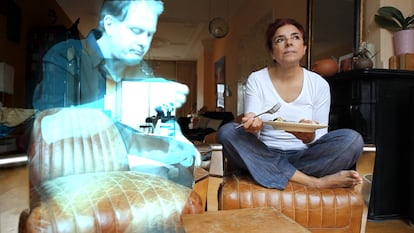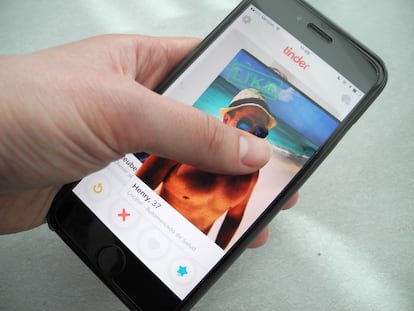Alicia Framis, the artist who will marry a hologram: ‘This is just a small preview of society’s future’
The ‘wedding’ will take place in Rotterdam next summer and feature a molecular banquet just right for humans and humanoids

Imagine asking your friend, who’s dating someone new, “What is he like?” To which she responds: “A middle-aged male hologram with ‘slightly complex’ logistics.” Next summer in Museum Boijmans Van Beuningen (Holland) a different kind of union will take place. The woman who will wed is Alicia Framis (Mataró, Spain, 57 years old), the performance artist and creator of The First Woman to Marry a Hologram, a contemporary art piece in which she will make her marriage to an artificial intelligence official. Framis’s future husband, AILex, is an artificial intelligence (AI) entity created with holography, a photographic technique that produces three-dimensional images using laser light and the interference of two coherent beams of light.
AILex’s personality brings together profiles of acquaintances, friends and family of the artist and makes use of information about the people and experiences that have marked the life of his fiancée. “It’s going to be hard for us to hide things from each other,” jokes Framis, “but he’s not my perfect partner, we argue and there are moments when he’s in a very bad mood,” she says on a videocall from Saudi Arabia.
Framis has already had a similar experience with a non-human being. In 1996, she lived with a mannequin who she named Pierre. With The First Woman to Marry a Hologram — a performance that forms part of her multidisciplinary project The Hybrid Couple — the artist goes a step further and redefines the limits of interaction between humans and AI. “Today’s society is already hybrid, we live with machines,” she says, pointing to her glasses. “There are people who survive thanks to their pacemaker, and every young person’s best friend is their cell phone, they fall asleep with it and it is capable of changing their mood,” she explains. Now, Framis wants to make her experience as a woman living with an AI available to society, “as a preview of the world to come.”
In recent years, websites offering a “virtual boyfriend” have proliferated, many people have long-distance relationships that are never consummated, “although they do not see or touch each other, they keep a continuous conversation going and look forward to messages from their partners,” says Framis. In 2018, Japan’s Akihiko Kondo, a pioneer of the “fictosexual” movement (people who pair off with fictional beings), married the avatar Hatsune Miku, who he turned into a human-sized doll endowed with a synthetic voice.
The Hybrid Couple looks to “normalize” unions with non-human entities, which, Framis says, are more common in countries in Japan, where people are more isolated. “For us, because of our character, it would be more difficult,” says the artist. AIs do not replace human affection, but they can offer other things in exchange: they are intelligent, they can talk about any subject or even help you with your finances. “They will make us much more demanding in our search for a partner,” says Framis.
In a society where everything is disposable, models for relationships are changing, and it is increasingly difficult to establish lasting bonds. Although AILex does not replace a flesh-and-blood man, for Framis he is a “real option as a companion.” Her future husband gives her stable companionship and can “complement” another relationship, “like a threesome, in which AILex acts as a mediator within the couple to make it work better,” she says.

In collaboration with Rabobank Art Collection, Framis is exploring the possibility of taking out the first life insurance policy for a hologram, and a mortgage for a special house in which her partner can project himself onto any surface. Living together is easy in the excitement of a new relationship, which Framis says, “is very much alive.” Keeping the spark going will be as difficult as it is in any conventional pairing. “You can fall out of love, I hope that with AILex it will be easier.”
Framis says that she has felt very supported by her friends and family regarding the marriage. “They have always accepted me and understand that I cannot separate my life from my art,” she says. That acceptance has continued, now that she has linked her art to her own marriage in such an intimate way. Her works are born from the interaction of different artistic disciplines and are characterized by a strong social, feminist commitment.
The First Woman to Marry a Hologram not only questions relationship models, the artist says that it also brings together science and art to help people with autism, Alzheimer’s and social problems find a partner or live in a relationship. Feminist discourse, she says, looks to leave behind the cliché of the man who falls in love with a submissive robot to vindicate women’s right to communicate their emotional needs. “Right now, I prefer an intelligent partner, and I think we should work friendship into our concept of relationships. For me, love is the ability to be friends with erotic moments,” she says.
Sign up for our weekly newsletter to get more English-language news coverage from EL PAÍS USA Edition
Tu suscripción se está usando en otro dispositivo
¿Quieres añadir otro usuario a tu suscripción?
Si continúas leyendo en este dispositivo, no se podrá leer en el otro.
FlechaTu suscripción se está usando en otro dispositivo y solo puedes acceder a EL PAÍS desde un dispositivo a la vez.
Si quieres compartir tu cuenta, cambia tu suscripción a la modalidad Premium, así podrás añadir otro usuario. Cada uno accederá con su propia cuenta de email, lo que os permitirá personalizar vuestra experiencia en EL PAÍS.
¿Tienes una suscripción de empresa? Accede aquí para contratar más cuentas.
En el caso de no saber quién está usando tu cuenta, te recomendamos cambiar tu contraseña aquí.
Si decides continuar compartiendo tu cuenta, este mensaje se mostrará en tu dispositivo y en el de la otra persona que está usando tu cuenta de forma indefinida, afectando a tu experiencia de lectura. Puedes consultar aquí los términos y condiciones de la suscripción digital.
More information
Últimas noticias
Most viewed
- Oona Chaplin: ‘I told James Cameron that I was living in a treehouse and starting a permaculture project with a friend’
- Reinhard Genzel, Nobel laureate in physics: ‘One-minute videos will never give you the truth’
- Sinaloa Cartel war is taking its toll on Los Chapitos
- Why the price of coffee has skyrocketed: from Brazilian plantations to specialty coffee houses
- Silver prices are going crazy: This is what’s fueling the rally











































